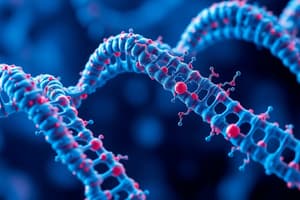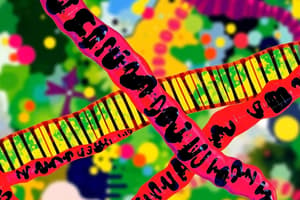Podcast
Questions and Answers
Which protein is associated with the poised state as mentioned in the content?
Which protein is associated with the poised state as mentioned in the content?
- H3K9 acetylation (correct)
- RNAPII
- BMAL1
- PER1
What does the presence of H3K9 acetylation indicate in the context of gene regulation?
What does the presence of H3K9 acetylation indicate in the context of gene regulation?
- Gene derepression (correct)
- Stable chromatin structure
- Delayed transcription initiation
- Active repression of genes
Which protein is NOT listed among the components related to the poised state?
Which protein is NOT listed among the components related to the poised state?
- NPAS2
- TP53 (correct)
- PER2
- CRY2
What role does RNAPII play in the gene expression process described in the content?
What role does RNAPII play in the gene expression process described in the content?
Which of the following proteins is suggested to collaborate with CBP in this regulatory framework?
Which of the following proteins is suggested to collaborate with CBP in this regulatory framework?
Which percentage corresponds to the H3K9 acetylation peaks as indicated?
Which percentage corresponds to the H3K9 acetylation peaks as indicated?
In which physiological process are the components mentioned most likely involved?
In which physiological process are the components mentioned most likely involved?
Which of the following pairs corresponds correctly to each protein's role in transcription regulation?
Which of the following pairs corresponds correctly to each protein's role in transcription regulation?
What does the HNF6 ChIP-seq signal indicate when shown in gray?
What does the HNF6 ChIP-seq signal indicate when shown in gray?
At what times were the HNF6 ChIP-seq signals measured in mouse livers?
At what times were the HNF6 ChIP-seq signals measured in mouse livers?
What colors are used to represent CLOCK:BMAL1 and HNF6 consensus sequences in the genomic locations display?
What colors are used to represent CLOCK:BMAL1 and HNF6 consensus sequences in the genomic locations display?
What was indicated by the disconnect between the amplitude of binding and rhythmicity according to the study?
What was indicated by the disconnect between the amplitude of binding and rhythmicity according to the study?
What was the sample size for the HNF6 ChIP-seq analysis in mice?
What was the sample size for the HNF6 ChIP-seq analysis in mice?
What role does CLOCK:BMAL1 play in transcription?
What role does CLOCK:BMAL1 play in transcription?
How does CLOCK:BMAL1 contribute to rhythmic transcriptional output?
How does CLOCK:BMAL1 contribute to rhythmic transcriptional output?
What sequence of events is most likely affected by CLOCK:BMAL1 activity?
What sequence of events is most likely affected by CLOCK:BMAL1 activity?
Which interaction does CLOCK:BMAL1 facilitate that is essential for transcription?
Which interaction does CLOCK:BMAL1 facilitate that is essential for transcription?
What experimental phase might demonstrate the influence of CLOCK:BMAL1 most strongly?
What experimental phase might demonstrate the influence of CLOCK:BMAL1 most strongly?
Which property distinguishes CLOCK:BMAL1 from other transcription factors?
Which property distinguishes CLOCK:BMAL1 from other transcription factors?
What is a characteristic feature of the binding sites for CLOCK:BMAL1?
What is a characteristic feature of the binding sites for CLOCK:BMAL1?
What implication arises from CLOCK:BMAL1's role in transcription?
What implication arises from CLOCK:BMAL1's role in transcription?
What role does CLOCK:BMAL1 play in relation to H2A.Z at transcription start sites (TSSs)?
What role does CLOCK:BMAL1 play in relation to H2A.Z at transcription start sites (TSSs)?
What happens to transcription in Bmal1 knockout mice compared to wild-type mice?
What happens to transcription in Bmal1 knockout mice compared to wild-type mice?
At what time point do H2A.Z levels reach a trough in wild-type mice?
At what time point do H2A.Z levels reach a trough in wild-type mice?
Which of the following is true about transcription factors binding at control sites?
Which of the following is true about transcription factors binding at control sites?
What is the correlation observed in H2A.Z signal and CLOCK:BMAL1 activity?
What is the correlation observed in H2A.Z signal and CLOCK:BMAL1 activity?
What is indicated about transcription factor binding at HNF6 sites?
What is indicated about transcription factor binding at HNF6 sites?
What happens to chromatin binding at rhythmic sites during the night?
What happens to chromatin binding at rhythmic sites during the night?
What is the significance of ZT22 in the context of H2A.Z levels?
What is the significance of ZT22 in the context of H2A.Z levels?
What role does the BMAL1-mediated rhythmic nucleosome removal play in relation to transcription factors?
What role does the BMAL1-mediated rhythmic nucleosome removal play in relation to transcription factors?
Which protein associated with transcription factors is mentioned in the content?
Which protein associated with transcription factors is mentioned in the content?
What is the focus of the analysis conducted on the mouse liver in the research referenced?
What is the focus of the analysis conducted on the mouse liver in the research referenced?
What statistical method was used for analyzing the publicly available mouse liver ChIP-seq data?
What statistical method was used for analyzing the publicly available mouse liver ChIP-seq data?
What biological element is H2A.Z associated with in this context?
What biological element is H2A.Z associated with in this context?
In the research, what aspect of the genes was analyzed through the ChIP-seq data?
In the research, what aspect of the genes was analyzed through the ChIP-seq data?
How many datasets were analyzed for transcription start sites (TSS) in the research?
How many datasets were analyzed for transcription start sites (TSS) in the research?
What factor is indicated to be necessary for establishing chromatin environment in the content?
What factor is indicated to be necessary for establishing chromatin environment in the content?
What percentage overlap do the black rectangles, representing transcription factors, exhibit with core clock genes?
What percentage overlap do the black rectangles, representing transcription factors, exhibit with core clock genes?
What does the nucleosome signal indicate at a CLOCK:BMAL1 DNA-binding site?
What does the nucleosome signal indicate at a CLOCK:BMAL1 DNA-binding site?
At what times are the average high nucleosome signals observed according to the document?
At what times are the average high nucleosome signals observed according to the document?
Which transcription factor is shown to have a consensus sequence along with CLOCK:BMAL1?
Which transcription factor is shown to have a consensus sequence along with CLOCK:BMAL1?
What color represents the low average nucleosome signals?
What color represents the low average nucleosome signals?
Which publication year is mentioned for the HNF6 ChIP-seq signal?
Which publication year is mentioned for the HNF6 ChIP-seq signal?
What is the visual representation of the transcription factors utilized in the data?
What is the visual representation of the transcription factors utilized in the data?
What does the gray signal in the nucleosome signal visualization denote?
What does the gray signal in the nucleosome signal visualization denote?
Flashcards
Poised State
Poised State
A state of readiness for gene expression.
H3K9 acetylation
H3K9 acetylation
A chemical modification of the histone protein H3, specifically at lysine 9, which can influence gene expression.
Gene Expression
Gene Expression
The process by which information from a gene is used to create a functional product, like a protein.
PER1
PER1
Signup and view all the flashcards
BMAL1
BMAL1
Signup and view all the flashcards
NPAS2
NPAS2
Signup and view all the flashcards
CRY2
CRY2
Signup and view all the flashcards
RNAPII
RNAPII
Signup and view all the flashcards
CLOCK:BMAL1
CLOCK:BMAL1
Signup and view all the flashcards
Pioneer transcription factor
Pioneer transcription factor
Signup and view all the flashcards
DNA-binding sites
DNA-binding sites
Signup and view all the flashcards
transcription
transcription
Signup and view all the flashcards
nucleosome removal
nucleosome removal
Signup and view all the flashcards
rhythmic gene expression
rhythmic gene expression
Signup and view all the flashcards
transcriptional output
transcriptional output
Signup and view all the flashcards
H2A.Z nucleosome
H2A.Z nucleosome
Signup and view all the flashcards
What happens to H2A.Z levels during the night?
What happens to H2A.Z levels during the night?
Signup and view all the flashcards
How does BMAL1 affect H2A.Z levels?
How does BMAL1 affect H2A.Z levels?
Signup and view all the flashcards
What is the relationship between CLOCK:BMAL1 binding and H2A.Z signal?
What is the relationship between CLOCK:BMAL1 binding and H2A.Z signal?
Signup and view all the flashcards
What is the role of CLOCK:BMAL1 in gene regulation?
What is the role of CLOCK:BMAL1 in gene regulation?
Signup and view all the flashcards
What is a transcription factor?
What is a transcription factor?
Signup and view all the flashcards
What is the significance of rhythmic binding of CLOCK:BMAL1?
What is the significance of rhythmic binding of CLOCK:BMAL1?
Signup and view all the flashcards
Where does CLOCK:BMAL1 bind?
Where does CLOCK:BMAL1 bind?
Signup and view all the flashcards
What is REV-ERBa's role in the circadian rhythm?
What is REV-ERBa's role in the circadian rhythm?
Signup and view all the flashcards
HNF6
HNF6
Signup and view all the flashcards
ChIP-seq
ChIP-seq
Signup and view all the flashcards
Consensus sequences
Consensus sequences
Signup and view all the flashcards
Nucleosome binding
Nucleosome binding
Signup and view all the flashcards
Rhythmic Nucleosome Removal
Rhythmic Nucleosome Removal
Signup and view all the flashcards
Transcription Factor Binding
Transcription Factor Binding
Signup and view all the flashcards
Genome Structure Correction
Genome Structure Correction
Signup and view all the flashcards
ChIP-seq Data
ChIP-seq Data
Signup and view all the flashcards
Overlap Analysis
Overlap Analysis
Signup and view all the flashcards
Mouse Liver
Mouse Liver
Signup and view all the flashcards
Nucleosome signal
Nucleosome signal
Signup and view all the flashcards
Transcription factors
Transcription factors
Signup and view all the flashcards
Circadian rhythm
Circadian rhythm
Signup and view all the flashcards
Study Notes
BSci 3230 Study Notes
- File Use Policy: These files are for BSci 3230 student exam preparation only. Sharing or using them for other purposes is prohibited. Material may be copyrighted.
Gene Expression Outputs of the Mammalian Clock
- TTFL Activation: The transcriptional-translational feedback loop (TTFL) leads to pervasive circadian transcription via CLOCK/BMAL1 activation.
- Circadian Transcription Methods: DNA microarray, RNA-seq, and ChIP are used to understand circadian transcription.
- Transcriptional Landscapes and Delay: The concept of "transcriptional landscapes" and the nature of the transcriptional delay are topics for further study.
Percentage of Genome Regulated by the Clock (Table 8.1)
- Data Source Variation/Update: Data collected circa 2004 may not reflect current estimates which have been shown to be higher
- Organism and Genome Percentage: Different organisms (cyanobacteria, fungi, insects, mammals, plants, marine algae) exhibit variable percentages of their genome undergoing clock-controlled regulation.
Mammalian TTFL: Transcriptional Outputs (CCGs)
- Diagram Description: A diagram depicting the mammalian transcriptional-translational feedback loop (TTFL), emphasizing the process of clock-controlled gene (CCG) transcription, encompassing nuclear translocation and cellular processes.
- Clock Output/Processes: The diagram highlights connections between the clock, its output processes, and rhythmic biological processes, illustrating feedback loops.
- Process Diagram: A schematic of interactions including the regulation of genes, cellular signalling pathways, interactions, and various molecule functions.
Transcriptional Control of mRNAs (Slide 5)
- Methods: DNA microarray technology using poly-A RNA and hybridization to DNA chips allows for the quantification of temporal patterns of gene expression.
Transcriptional Control of mRNAs: Mouse Tissue Studies (Slides 6-7)
- Tissue Sampling: Mouse tissues (SCN and liver) were initially sampled for mRNA analysis.
- Gene Assay Numbers: Approximately 7000 genes were screened, with 337 displaying rhythmic expression in the SCN and 335 in the liver.
- Phase Specific Genes: Identified rhythmic genes exhibited "phase specificity", differing in peak expression times in different tissues.
- Tissue Specific Rhythmic Genes: While many genes cycle rhythmically, a smaller subset (≈28) show rhythms in both tissues.
Transcriptional Control of RNAs Including Non-Coding RNAs (Slides 8-9)
- RNA-Seq Technique: RNA sequencing (RNA-seq) methods and workflow for analysing transcriptomes in 12 mouse organs over time are detailed.
- Organ-specific Manner: 43% of all protein-coding genes show circadian rhythms in some tissue.
- Protein-Coding and Non-Coding RNA: Data on numbers and percentages of circadian-regulated protein-coding genes and various types of non-coding RNAs is presented, including novel, conserved, and non-conserved.
Relationships among Organs and Circadian Genese (Slide 10)
- Organ-Specific Oscillations: Amplitude, phase, and rhythmic behavior of circadian genes are different across various tissues.
- Histograms and Venn Diagrams: Graphs depicting the distribution of gene expression amplitudes and phases, plus comparisons/overlap of expression across tissues.
Transcriptional Control of Proteins (TFs?) Bound to DNA (Slides 11-15)
- ChIP Technique: Chromatin Immunoprecipitation (ChIP) is employed to study changes in transcription factor binding.
- DNA-Protein Crosslinking: Chromatin extraction from different phases, DNA crosslinking, fragmentation and sonication are part of the steps of the ChIP protocol.
- Immunoprecipitation: Antibodies to specific transcription factors are used to isolate bound DNA.
- De-Crosslinking and Sequencing: The bound DNA is extracted, sequenced and analysed.
- Circadian Control of Protein Binding (Slides 12-15): Analysis of the binding of core circadian regulators (including BMAL1, CLOCK, NPAS2, PER1, PER2, CRY1, CRY2) within the DBP gene within the liver is shown via various graphs and plots.
Transcriptional Control of Proteins (TFs?): Supplementary details (16-18)
- Intron-Exon-Specific mRNAs: Analysis of intron- and exon-specific mRNA cycling reveals that most intron and exons cycling is governed by changes in RNA production at the transcriptional level.
- Phases of Transcription and Regulation: Discussion of circadian regulation of gene expression at both transcriptional and post-transcriptional levels.
- Alternative Explanations for Delay: Alternative reasons for the observed delay between CLOCK/BMAL1 binding and transcription initiation are considered.
CLOCK-BMAL1 Pioneer Transcription Factor (Slides 19-21)
- Pioneer Function: CLOCK-BMAL1's function as a pioneer transcription factor is explained, highlighting its role in facilitating the binding of other transcription factors.
- Mechanism: The details of the CLOCK-BMAL1-DNA binding process, chromatin modifications, and accompanying histone and nucleosome changes are presented.
- Binding of other TFs: Subsequent binding of other transcription factors is driven by CLK-BMAL1-induced chromatin remodeling allowing for transcriptional activation by these other TFs.
Gene Ontology: KEGG Metabolic Pathways (Slides 22-23)
- Metabolic Pathway Map Visual representation of KEGG metabolic pathways, emphasizing connections.
- BMAL1-regulated KEGG Metabolic Pathways: Specific pathways associated with BMAL1 regulation are shown within this visual representation.
Food for Thought (Slide 24)
- Implications of Pervasive Regulation: Exploring the possible consequences of widespread clock regulation and the role of clock disruption in animal health.
- Testing for Clock Control: Methods for evaluating the significance of clock control for particular transcriptional pathways are proposed.
Studying That Suits You
Use AI to generate personalized quizzes and flashcards to suit your learning preferences.
Related Documents
Description
Test your knowledge on the proteins and mechanisms involved in gene regulation, particularly focusing on the poised state and the significance of H3K9 acetylation. This quiz covers various aspects of transcription factors and their roles in gene expression as discussed in recent research.



